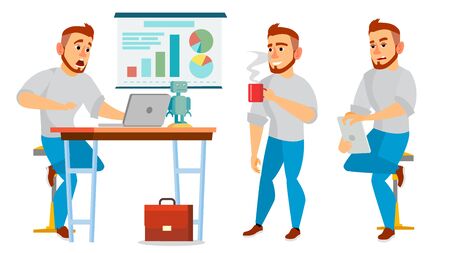Introduction to Ergonomics in UK Offices
In today’s fast-paced British work environment, the concept of ergonomics is becoming increasingly vital for organisations aiming to boost employee well-being and productivity. Ergonomics—sometimes referred to as human factors—focuses on designing office spaces and tools that suit the needs of employees, minimising discomfort and reducing the risk of workplace injuries. As more businesses across the UK adopt hybrid and flexible working patterns, the importance of a well-designed workspace has never been greater.
Why Ergonomics Matters in British Workplaces
The modern British office is evolving, with open-plan layouts, hot-desking, and remote work reshaping traditional setups. However, poor ergonomic practices can lead to musculoskeletal problems, reduced concentration, and increased absenteeism. By investing in ergonomic solutions, UK employers not only comply with health and safety regulations but also foster a culture of care that enhances morale and retention rates.
Key Benefits of Proper Workspace Design
| Benefit | Impact on Employees |
|---|---|
| Improved Posture | Reduces back and neck pain |
| Enhanced Productivity | Supports focus and efficiency |
| Lower Absenteeism | Fewer sick days due to strain or injury |
| Higher Job Satisfaction | Boosts morale and engagement |
Summary
Embracing ergonomics in UK offices is more than a trend—it’s a strategic investment in people. When workspaces are designed with employee health in mind, businesses see tangible improvements in output, staff happiness, and overall workplace culture.
2. Recognising Common Workplace Health Issues
Understanding the most common health concerns in UK offices is key to creating ergonomic workspaces that genuinely support employee wellbeing. In Britain, office workers face a range of issues, from musculoskeletal disorders (MSDs) to eye strain and mental fatigue, often exacerbated by long hours at desks and inadequate workplace design.
Musculoskeletal Disorders in UK Offices
MSDs remain one of the leading causes of workplace absence in the UK. According to the Health and Safety Executive (HSE), over 470,000 workers suffered from work-related MSDs in 2022/23, with office environments being significant contributors due to poor posture, repetitive tasks, and insufficiently adjustable equipment.
| Health Issue | UK Office Worker Impact | Key Causes |
|---|---|---|
| Musculoskeletal Disorders (MSDs) | 470,000+ affected annually | Poor posture, inadequate seating, repetitive movement |
| Eye Strain | 60% report symptoms weekly | Prolonged screen time, improper monitor height, lighting issues |
| Mental Fatigue & Stress | Over 17 million days lost yearly | High workload, lack of breaks, insufficient workspace variety |
Eye Strain: The Digital Dilemma
With remote and hybrid working on the rise across the UK, digital eye strain has become increasingly prevalent. A recent survey by the British Occupational Health Research Foundation found that nearly 60% of office staff experience symptoms such as dryness, blurred vision, and headaches at least once a week. This trend highlights the urgent need for tailored ergonomic solutions like adjustable monitors and ambient lighting controls in UK offices.
Mental Fatigue and Workplace Stress
Mental wellbeing is just as important as physical comfort. Data from the Office for National Statistics (ONS) shows stress-related conditions accounted for more than 17 million lost working days in 2023. Open-plan layouts, high noise levels, and limited access to quiet zones all contribute to cognitive overload among British office workers. Addressing these factors through thoughtful workspace design can significantly reduce burnout rates and boost productivity.

3. Key Principles of Ergonomic Office Design
Creating an ergonomic office in the UK requires more than simply choosing modern furniture; it’s about applying core principles that address the unique needs of diverse roles and individuals. Here’s how to get it right:
Workstation Setup Essentials
Every employee spends hours at their desk, making correct workstation setup vital. In UK offices, it’s important to adjust for varying heights, tasks, and equipment. Below is a quick-reference table for optimal setup:
| Component | Recommended Adjustment | UK Office Tip |
|---|---|---|
| Chair | Adjust seat height so feet are flat on the floor, knees at 90° | Choose chairs certified to BS EN 1335 standards |
| Desk | Elbows at desk level when typing; 70-80cm high for most adults | Consider height-adjustable desks for flexibility |
| Monitor | Top of screen at or slightly below eye level, arm’s length away | Position perpendicular to windows to avoid glare from British weather changes |
The Importance of Posture
Poor posture is a leading cause of musculoskeletal issues in UK workplaces. Encourage staff to:
- Sit upright with shoulders relaxed
- Keep wrists straight when typing or using a mouse
- Avoid crossing legs for long periods to promote circulation
Customising Solutions: One Size Doesn’t Fit All
Diversity in roles—from finance teams to creative designers—means workspaces must be adaptable. Effective ergonomic design in British offices considers individual preferences, job tasks, and even left- or right-handedness. For example:
- Customer service agents may need headsets and adjustable monitor arms
- Designers benefit from larger screens and flexible lighting options
Personalised Ergonomics Checklist
- Conduct regular assessments using DSE (Display Screen Equipment) guidance as per HSE regulations
- Offer a range of accessories: footrests, lumbar supports, document holders
Takeaway for UK Managers:
A proactive approach—combining assessment with tailored adjustments—ensures employee comfort and productivity across all office environments.
4. Practical Steps to Optimise Office Workspaces
For British companies seeking to enhance employee health and productivity, applying ergonomic principles is not just about buying the latest equipment—its about making informed choices and fostering healthy habits at work. Here are actionable steps you can take to create a workspace that prioritises wellbeing and efficiency.
Choosing the Right Desks and Chairs
Investing in adjustable furniture is crucial. Look for desks with height-adjustable features, allowing employees to alternate between sitting and standing. When selecting chairs, prioritise models with lumbar support, seat height adjustability, and armrests that promote a neutral posture.
| Feature | Recommended Specification |
|---|---|
| Desk Height | Adjustable (typically 65-125cm) |
| Chair Support | Lumbar support, adjustable seat height (40-52cm), armrests |
| Material | Breathable fabric or mesh for comfort |
Screen Positioning for UK Offices
The positioning of computer screens greatly affects posture and eye health. Place monitors directly in front of the user at arm’s length, with the top of the screen at or just below eye level. Dual screens should be angled slightly towards the user to reduce neck strain.
Screen Placement Checklist:
- Monitor is one arm’s length away from user
- The top of the screen aligns with eye level
- No glare from windows or overhead lights
- Cables managed to prevent trip hazards
Optimising Lighting Conditions
Poor lighting can cause eye strain and headaches. UK offices often have variable natural light due to weather; supplement with adjustable LED task lights where necessary. Encourage the use of blinds to control sunlight and minimise screen glare.
| Lighting Type | Best Practice |
|---|---|
| Natural Light | Maximise daylight; position desks perpendicular to windows |
| Artificial Light | Use LED task lighting; avoid harsh overheads |
| Glare Reduction | Install blinds or filters on windows as needed |
Promoting Regular Movement Throughout the Day
Sedentary behaviour is a leading cause of musculoskeletal problems in UK office workers. Encourage short breaks every 30-60 minutes; consider setting up shared standing meeting spaces and walking routes within the office.
Tips to Encourage Activity:
- Set reminders for staff to stand up or stretch regularly
- Create a culture where walking meetings are normalised
- Provide access to communal breakout areas for informal movement
- Display posters or digital prompts encouraging movement around the workspace
By implementing these practical steps, British companies can build healthier, more productive office environments that reflect best-in-class ergonomic standards while supporting employee wellbeing long-term.
5. Technology’s Role in Modern Ergonomics
Modern UK offices are rapidly adopting technology-driven solutions to create healthier, more efficient work environments. The integration of smart devices, sit-stand desks, and ergonomic accessories is transforming the way British employees work and interact with their workspace. These tools not only foster comfort but also significantly enhance productivity and wellbeing.
Smart Devices: Monitoring and Adjusting for Health
Wearable technology and smart office systems are increasingly popular in the UK. Devices such as posture trackers and environmental sensors help employees monitor their sitting habits, alert them when it’s time to move, and even adjust lighting or temperature for optimal comfort. This data-driven approach empowers staff to make real-time adjustments, reducing fatigue and promoting sustained focus throughout the workday.
Sit-Stand Desks: Encouraging Movement
The adoption of sit-stand desks across UK offices is a practical response to concerns over sedentary lifestyles. These desks allow employees to alternate between sitting and standing, minimising the health risks associated with prolonged periods at a desk. The flexibility encourages micro-movements, which helps alleviate back pain and improves circulation—common concerns flagged in British workplace health surveys.
Benefits Comparison: Standard vs Sit-Stand Desks
| Feature | Standard Desk | Sit-Stand Desk |
|---|---|---|
| Posture Support | Limited | High (dynamic adjustment) |
| Movement Encouragement | Minimal | Frequent changes possible |
| Health Impact | Risk of sedentary issues | Reduces back/neck strain |
Ergonomic Accessories: Tailoring Comfort
From adjustable monitor arms to supportive chairs and wrist rests, ergonomic accessories play a vital role in customising UK workspaces. These additions cater to individual body types and working preferences, ensuring that each employee can maintain a neutral posture while minimising repetitive strain injuries common in office settings.
Examples of Popular Ergonomic Accessories in UK Offices:
- Lumbar support cushions for traditional British office chairs
- Split keyboards designed for improved wrist alignment
- Footrests to aid shorter employees using standard-height desks
The strategic implementation of these technologies is helping UK businesses not only meet legal obligations under Health & Safety Executive (HSE) guidelines but also drive measurable improvements in staff satisfaction and operational efficiency.
6. Building a Culture of Health and Wellbeing
Fostering a robust culture of health and wellbeing in UK offices goes beyond simply providing ergonomic furniture or adjusting desk heights. It requires a strategic, ongoing commitment from employers to support their teams holistically. Here’s how UK organisations can cultivate such an environment:
Implementing Comprehensive Health Policies
UK businesses should create clear, accessible health and wellbeing policies that prioritise ergonomics and employee welfare. These policies should outline the organisation’s commitment to providing safe workspaces, regular workstation assessments, and proactive adjustments based on employee needs. This not only helps meet legal obligations under the Health and Safety at Work Act but also demonstrates genuine care for staff.
Delivering Targeted Employee Training
Investing in training sessions empowers staff to understand ergonomic principles and apply them daily. Topics can include correct posture, how to adjust office chairs, setting up display screens, and recognising early signs of discomfort. Regular workshops or online modules tailored to UK office environments ensure everyone is equipped with practical knowledge.
Example: Ergonomics Training Schedule
| Session Topic | Frequency | Delivery Method |
|---|---|---|
| Workstation Setup | Quarterly | In-person/Online |
| Posture & Movement | Bi-annually | Interactive Workshop |
| Mental Wellbeing at Work | Annually | E-learning Module |
Ongoing Assessment of Ergonomic Practices
Continuous improvement is key. Employers should regularly review ergonomic practices through surveys, feedback channels, and periodic risk assessments. Incorporating employee input ensures solutions are both relevant and effective within the unique context of British workplaces.
Key Strategies for Fostering Wellbeing Culture
| Strategy | Description |
|---|---|
| Health Policy Review | Update policies annually to reflect latest best practices and legislation. |
| Employee Engagement | Create forums for feedback on office ergonomics and wellbeing. |
| Access to Resources | Provide guides, toolkits, and helplines for immediate support. |
A Proactive Approach Pays Off
Cultivating a culture of health and wellbeing isn’t just good practice—it’s a smart investment. UK employers who champion ergonomics enjoy higher productivity, reduced absenteeism, and improved morale across the workforce. The result is a resilient, engaged team ready to thrive in any office environment.
7. Future Outlook: Trends and Regulations in the UK
The landscape of office ergonomics in the UK is evolving rapidly, driven by technological advancements, changing work patterns, and a growing recognition of employee well-being. Employers are expected to stay ahead of these changes to foster healthier and more productive work environments.
Upcoming Ergonomic Trends
- Hybrid Workspaces: As hybrid and remote working models become standard, offices are shifting towards flexible layouts with adaptable desks, hot-desking solutions, and collaborative zones.
- Smart Technology Integration: The rise of IoT and smart devices enables real-time monitoring of posture, air quality, and lighting, providing personalised ergonomic adjustments for employees.
- Sustainable Ergonomics: Sustainable furniture choices and eco-friendly materials are increasingly prioritised, supporting both health and environmental goals.
Government Guidance: HSE Recommendations
The Health and Safety Executive (HSE) continues to play a pivotal role in shaping ergonomic standards in Britain. Key areas include:
| Regulation/Guidance | Description |
|---|---|
| DSE (Display Screen Equipment) Regulations | Mandates regular workstation assessments and risk management for all screen users. |
| Manual Handling Operations Regulations | Focuses on safe practices for lifting, moving, and handling equipment in offices. |
| Mental Health & Wellbeing Initiatives | Encourages holistic approaches combining physical ergonomics with mental health support. |
Evolving Expectations for British Workplaces
- Employees now expect proactive wellbeing measures from employers, including sit-stand desks, ergonomic chairs, and comprehensive training.
- Regular reviews and updates of workspace design are becoming the norm to accommodate diverse needs and new working styles.
The Road Ahead: A Summary
To remain compliant and competitive, UK organisations must keep pace with evolving ergonomic standards—leveraging government guidance and embracing innovative trends. Prioritising employee health through strategic workspace design not only fulfils legal obligations but also drives productivity, engagement, and long-term business success.


